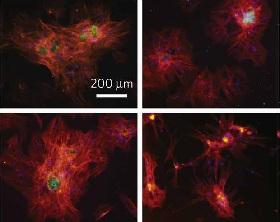Digital wellbeing should be a public health priority for the Arab region
21 October 2025
Published online 7 August 2011

Adult stem cell therapy involves extracting a few pluripotent cells from a patient, growing them in the lab up to a hundred/thousand fold more and then injecting them back into the patient in the hope they will eventually regenerate diseased or damaged tissue. But expanding these cells is problematic: over time they lose their multipotency, which is their ability to give rise to different cell types, and hence lose their usefulness.
Now, a study in Nature Materials suggests that growing stem cells on an ordered nanomaterial can help maintain multipotency for up to 8 weeks.
A team of biologists and material engineers, centred around Glasgow and Southampton and including King Saud University in Riyadh, employed electron beam lithography, a technology developed for microchip design, to fabricate a silicon template with pits 120nm wide spaced 300nm apart. This is used as a master template to make many plastic replicas through embossing or injection moulding. This could potentially form the growth part of standard cell culture flasks.
Growing mesenchymal stem cells (MSC) derived from bone marrow on the nanomaterial helped maintain the growing population's potential to become various cells, such as osteoblasts (bone) and adipocytes (fat). The researches demonstrate that the tiny pits alter the action of integrin receptors embedded in the cell membrane that control cell signals and interact with other cells. Small, untranslated RNAs were also up-regulated in the cells. Both are thought to slow the cell's rate of metabolism, and help the cells retain their multipotency.
Now the team are testing whether the nanomaterial preserves various other types of stem cells, including neuronal, and whether the nanostuctured arrays need to be reconfigured.
doi:10.1038/nmiddleeast.2011.100
Stay connected: